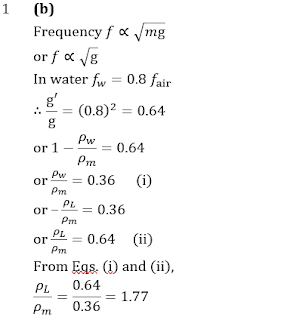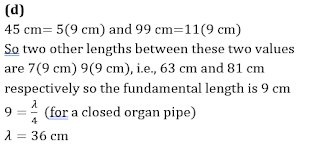JEE Advanced paper is considered to be one of the toughest entrance exams in India. Moreover, this Physics is considered the toughest subject because it is the most application-based. The student needs to get the basics right and then move on to mastering advanced concepts. Waves consist of nearly about 4-5 % of marks in the Physics section.
Q1. The frequency of a sonometer wire is 10 Hz. When the weights producing the tension are completely immersed in water the frequency becomes 80 Hz and on immersing the weights in a certain liquid the frequency becomes 60 Hz. The specific gravity of the liquid is
Q2. The mathematical form of three travelling waves is given by
Y1 = (2 cm) sin(3x-6t)
Y2 = (3 cm) sin(4x-12t)
And Y3 = (4 cm) sin(5x-11t)
of these waves
Y1 = (2 cm) sin(3x-6t)
Y2 = (3 cm) sin(4x-12t)
And Y3 = (4 cm) sin(5x-11t)
of these waves
Solution
(d)
For the wave, y=A sin (kx - ωt), the wave speed is ω / k and the maximum transverse string is A ω
(d)
For the wave, y=A sin (kx - ωt), the wave speed is ω / k and the maximum transverse string is A ω
Q4. A closed organ pipe and an open organ pipe of same length produce 2 beats when they are set into vibration simultaneously in their fundamental mode. The length of the open organ pipe is now halved and of the closed organ pipe is doubled; the number of beats produced will be
Q5. The amplitude of a wave disturbance propagating along positive X-axis is given by y = 1 / ( 1 + x2 ) at t=0 and y = 1 / [ 1 + (x-2)2 ] at t = 4 s where x and y are in metre. The shape of wave disturbance does not change with time. The velocity of the wave is
Q7. An air column closed at one end and opened at the other end, resonates with a tuning fork of frequency v when its length is 45 cm and 99 cm and at two other lengths in between these values. The wavelength of sound in air column is
Q8. Two waves having intensity I and 9I produce interference. If the resultant intensity at a point is 7I, what is the phase difference between the two waves?
Q9. A siren placed at a railway platform is emitting sound of frequency 5 kHz. A passenger sitting in a moving train A records a frequency of 5.5 kHz while the train approaches the siren. During his return journey in a different train B he records a frequency of 6.0 kHz while approaching the same siren. The ratio of velocity of train B to that of train A is
Q10. A closed organ pipe has length ‘l’. The air in it is vibrating in 3rd overtone with maximum amplitude ‘a’. The amplitude at a distance of l/7 from closed end of the pipe is equal to


















